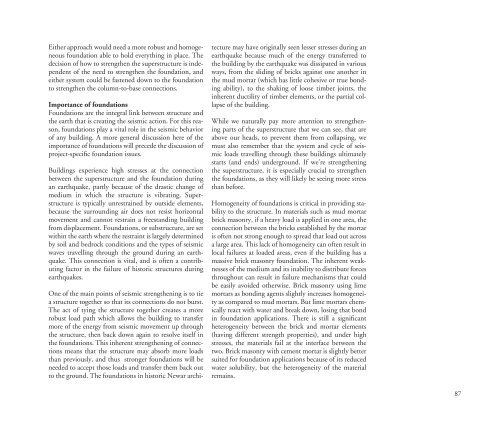KVPT’s Patan Darbar Earthquake Response Campaign - Work to Date - September 2016
You also want an ePaper? Increase the reach of your titles
YUMPU automatically turns print PDFs into web optimized ePapers that Google loves.
Either approach would need a more robust and homogeneous<br />
foundation able <strong>to</strong> hold everything in place. The<br />
decision of how <strong>to</strong> strengthen the superstructure is independent<br />
of the need <strong>to</strong> strengthen the foundation, and<br />
either system could be fastened down <strong>to</strong> the foundation<br />
<strong>to</strong> strengthen the column-<strong>to</strong>-base connections.<br />
Importance of foundations<br />
Foundations are the integral link between structure and<br />
the earth that is creating the seismic action. For this reason,<br />
foundations play a vital role in the seismic behavior<br />
of any building. A more general discussion here of the<br />
importance of foundations will precede the discussion of<br />
project-specific foundation issues.<br />
Buildings experience high stresses at the connection<br />
between the superstructure and the foundation during<br />
an earthquake, partly because of the drastic change of<br />
medium in which the structure is vibrating. Superstructure<br />
is typically unrestrained by outside elements,<br />
because the surrounding air does not resist horizontal<br />
movement and cannot restrain a freestanding building<br />
from displacement. Foundations, or substructure, are set<br />
within the earth where the restraint is largely determined<br />
by soil and bedrock conditions and the types of seismic<br />
waves travelling through the ground during an earthquake.<br />
This connection is vital, and is often a contributing<br />
fac<strong>to</strong>r in the failure of his<strong>to</strong>ric structures during<br />
earthquakes.<br />
One of the main points of seismic strengthening is <strong>to</strong> tie<br />
a structure <strong>to</strong>gether so that its connections do not burst.<br />
The act of tying the structure <strong>to</strong>gether creates a more<br />
robust load path which allows the building <strong>to</strong> transfer<br />
more of the energy from seismic movement up through<br />
the structure, then back down again <strong>to</strong> resolve itself in<br />
the foundations. This inherent strengthening of connections<br />
means that the structure may absorb more loads<br />
than previously, and thus stronger foundations will be<br />
needed <strong>to</strong> accept those loads and transfer them back out<br />
<strong>to</strong> the ground. The foundations in his<strong>to</strong>ric Newar architecture<br />
may have originally seen lesser stresses during an<br />
earthquake because much of the energy transferred <strong>to</strong><br />
the building by the earthquake was dissipated in various<br />
ways, from the sliding of bricks against one another in<br />
the mud mortar (which has little cohesive or true bonding<br />
ability), <strong>to</strong> the shaking of loose timber joints, the<br />
inherent ductility of timber elements, or the partial collapse<br />
of the building.<br />
While we naturally pay more attention <strong>to</strong> strengthening<br />
parts of the superstructure that we can see, that are<br />
above our heads, <strong>to</strong> prevent them from collapsing, we<br />
must also remember that the system and cycle of seismic<br />
loads travelling through these buildings ultimately<br />
starts (and ends) underground. If we’re strengthening<br />
the superstructure, it is especially crucial <strong>to</strong> strengthen<br />
the foundations, as they will likely be seeing more stress<br />
than before.<br />
Homogeneity of foundations is critical in providing stability<br />
<strong>to</strong> the structure. In materials such as mud mortar<br />
brick masonry, if a heavy load is applied in one area, the<br />
connection between the bricks established by the mortar<br />
is often not strong enough <strong>to</strong> spread that load out across<br />
a large area. This lack of homogeneity can often result in<br />
local failures at loaded areas, even if the building has a<br />
massive brick masonry foundation. The inherent weaknesses<br />
of the medium and its inability <strong>to</strong> distribute forces<br />
throughout can result in failure mechanisms that could<br />
be easily avoided otherwise. Brick masonry using lime<br />
mortars as bonding agents slightly increases homogeneity<br />
as compared <strong>to</strong> mud mortars. But lime mortars chemically<br />
react with water and break down, losing that bond<br />
in foundation applications. There is still a significant<br />
heterogeneity between the brick and mortar elements<br />
(having different strength properties), and under high<br />
stresses, the materials fail at the interface between the<br />
two. Brick masonry with cement mortar is slightly better<br />
suited for foundation applications because of its reduced<br />
water solubility, but the heterogeneity of the material<br />
remains.<br />
87




